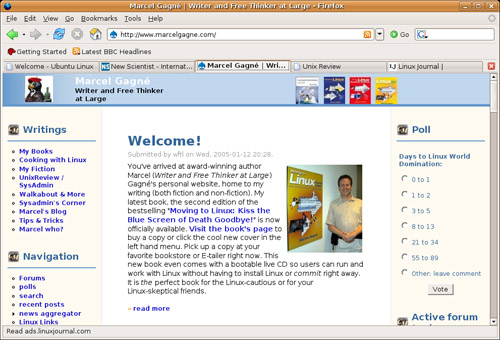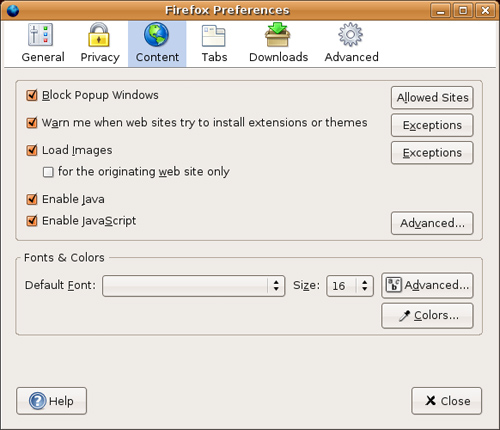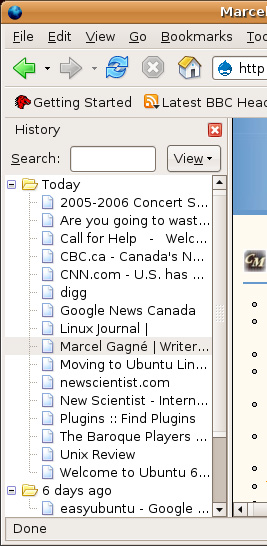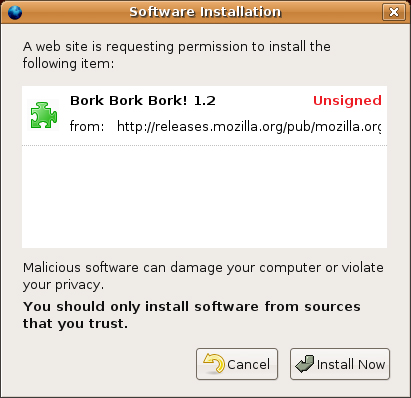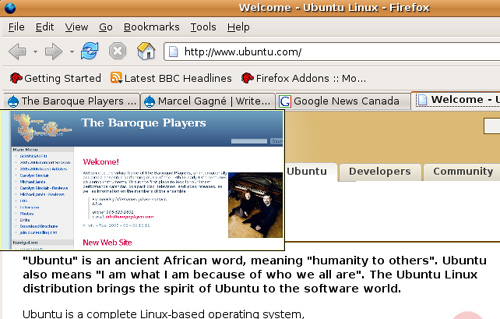Chapter 10 Surfing the Net with Firefox
When it comes to Web browsers on the desktop, Linux users are faced with an embarrassment of riches with plenty of alternatives to choose from. For those who are looking for a screaming fast browsing experience and can do without the graphics, Linux offers a number of text-based browsers. (I’ll mention these briefly at the end of the chapter.)
In the graphical world where most people spend their browsing time, the hottest and coolest browser of the day is Firefox, and it just happens to be the default browser found in Ubuntu Linux. Before Firefox made its appearance a short while ago, everyone assumed that the browser world belonged to the browser from Redmond, the security-problem-plagued Internet Explorer. As I write this, Internet Explorer has dipped to below 90 percent of the browser market share in North America and below 80 percent in Europe. This is quite the feat considering that Internet Explorer commanded something around 95 percent of the market before Firefox. Better security and advanced features have drawn millions of users away from Microsoft’s browser. Firefox is an exciting program and I’ll show you how it works in this chapter.
Firefox is distributed by the same people who distribute the Mozilla browser. In fact, Firefox is a Mozilla product.
What’s the difference between Mozilla and Firefox? The actual Mozilla browser is more like the Swiss Army knife of browsers. It includes an email package and IRC client, is ideal for reading newsgroups, and comes with an HTML editor. Firefox, on the other hand, is strictly a Web browser (see Figure 10-1). It’s smaller, faster, and more geared to its primary job, providing you with a superior surfing experience. To get the equivalent standalone email package, you would download Thunderbird (mentioned in Chapter 11). Right now, I’d like to concentrate on Firefox, so let’s get started.
To start Firefox, click the Application menu in the top panel, navigate to the Internet submenu, and then select Firefox Web Browser. There’s also a quick access icon for Firefox in the top panel. Directly to the right of the System menu, there’s a blue globe. Pause your mouse cursor over the icon and it identifies itself as Firefox.
When you first start Firefox, it takes you to its home, currently a Welcome to Ubuntu page, locally installed on your system. The location is identified in the URL/location bar directly below the menu bar. Getting to a Web site and navigating Firefox is much the same as it is in any other browser you have used, particularly if you were using Mozilla (or Firefox) with your old OS. All you do is type the URL of the Web site you want to visit into the location bar, and away you go. If you would like to start each time on a personal home page, this is easily done.
![]() Tip Take the time to check out and visit the links on the Ubuntu welcome page. They point to some valuable resources, some of which you may want to bookmark.
Tip Take the time to check out and visit the links on the Ubuntu welcome page. They point to some valuable resources, some of which you may want to bookmark.
Click Edit in Firefox’s menu bar and select Preferences. The Preferences window opens up with a number of icons running along the top, directly under the title bar, from which you select what part of Firefox you want to modify. By default, it opens up to the General category (see Figure 10-2). Directly below, in the Home Page section, there are three buttons. The first button, Use Current Page, enters whatever URL (or page) you are currently visiting into the Location field as your home page. The middle button, Use Bookmark, brings up a dialog with your current bookmarks. Clicking the Use Blank Page button starts Firefox on a blank page. Of course, you could just type the URL into the Location field, click OK, and be done.
![]() Quick Tip Before closing the Preferences dialog, did you notice that the Location field actually says Location(s)? That’s right, it could be plural. If you have multiple tabs open (which I’ll cover next), the Use Current Page button becomes Use Current Pages. When you click the Home icon, Firefox opens tabs to all your favorite pages. If you want to manually enter a list of pages into the location bar, just separate each page with the pipe symbol,
Quick Tip Before closing the Preferences dialog, did you notice that the Location field actually says Location(s)? That’s right, it could be plural. If you have multiple tabs open (which I’ll cover next), the Use Current Page button becomes Use Current Pages. When you click the Home icon, Firefox opens tabs to all your favorite pages. If you want to manually enter a list of pages into the location bar, just separate each page with the pipe symbol, | (usually found above the backslash key on your keyboard).
Firefox sports a great feature called tabbed browsing. Here’s how it works.
Sometimes when you are viewing Web sites, you want to keep a particular site open while moving to another place on the Web. Normally, you click File and select New Window. This is fine, except that if you keep doing this, you’ll wind up with many versions of a browser open on your desktop. Switching from one to the other involves doing a little digital juggling. Tabs make it possible to bring a nice, clean air of sanity to what could otherwise become a very cluttered taskbar (or desktop). With tabbed browsing, you open additional Web sites in the same browser window, and then move from one to the other by clicking the open site’s appropriate tab.
Here’s how you do it. Start by visiting a site of your choice. Now click File, select New, and choose New Tab from the drop-down menu. You can also use the <Ctrl+T> keyboard shortcut to do the same thing. Notice that Firefox identifies your sites with tabs just below the location bar (see Figure 10-3), or if you have it turned on, your Bookmarks toolbar. Add a third or a fourth tab if you like. Switching from site to site is now just a matter of clicking the tabs on your single copy of Firefox.
![]() Tip Here’s a cool trick. In the Linux world, there’s a right mouse button, a left mouse button, and, often, a middle mouse button. Even if you don’t have a middle mouse button, you can still mimic the action of the middle button by pressing the left and right buttons at the same time. Many applications, including your desktop environment, can take advantage of this middle button (or phantom middle button).
Tip Here’s a cool trick. In the Linux world, there’s a right mouse button, a left mouse button, and, often, a middle mouse button. Even if you don’t have a middle mouse button, you can still mimic the action of the middle button by pressing the left and right buttons at the same time. Many applications, including your desktop environment, can take advantage of this middle button (or phantom middle button).
Why am I telling you this? Click a link using the middle button and that link automagically opens up in a new tab. Cool? Cool.
While in tab mode (as shown in Figure 10-3), you can right-click a tab to bring up the tab menu. From there, you can close or reload the current tab (or all tabs) and even open new tabs. Another way to close the active tab is to click the X at the end of the tab list.
![]() Tip After you have several tabs open, you might decide that you would like a particular site in another position. Let’s say that you are using one site more than another and you would like it in the first position but it is currently at the end. No problem. Just click the tab and drag it to the new position.
Tip After you have several tabs open, you might decide that you would like a particular site in another position. Let’s say that you are using one site more than another and you would like it in the first position but it is currently at the end. No problem. Just click the tab and drag it to the new position.
Just as there’s no comparison between your old twenty-inch TV and that new fifty-inch flat panel HDTV, nothing beats looking at the virtual world through a big screen. As much as I would like to, I can’t increase the size of your monitor, but I can help you with the next best thing. When you are busy surfing the Internet and you want as much screen as possible, why not try Firefox’s full-screen mode?
At any time while you are viewing a page, you can click View on the menu bar and select Full Screen. The title bar disappears, as do the top and bottom panels and all other border decorations. Another, quicker way to switch to full-screen mode is to press <F11>. Pay attention to this because this is how you switch back to normal view.
Honestly, I can’t think of a single person who likes to visit a Web site, only to have that site throw up annoying pop-up window ads. Firefox lets you stop this easily. Actually, Firefox has pop-ups blocked by default, but you may want to alter that behavior for some sites. Here’s how.
Start by bringing up the Preferences menu again (click Edit on the menu bar and choose Preferences). From the category list, choose Content (see Figure 10-4). You’ll see a check box labeled Block Popup Windows. Next to that label is a button labeled Allowed Sites. Clicking this button allows you to specify sites where pop-ups may be desirable. When you are satisfied with your configuration, click OK to close the Preferences menu.
When Firefox intercepts a pop-up, it displays a message like the one in Figure 10-5.
Clicking the Preferences button at the end of the bar offers you three choices. You can allow pop-ups for that particular Web site or edit the pop-up blocker preferences for that particular Web site. You also have the option of choosing never to see the message when pop-ups are blocked.
Not that kind of cookie. Cookies are simply small text files transmitted to your browser (or system) when you visit a Web site. The original idea behind cookies was that a server would give you a cookie as a marker to indicate where you had previously visited. That cookie might store a username and password to access a particular Web site or other information related to your visit, such as an online shopping cart. When you next visit the site, the server would ask your browser whether it had served you any cookies, and your browser would reply by sending the cookies from before. In this way, the Web site would recognize you when you next visited, and certain useful defaults would be set up for you. Cookies can be very good.
The problem with cookies is that they can also be shared within larger domains, such as advertising rings. Using these shared cookies, advertisers can build a profile of your likes and dislikes, tailoring and targeting advertising to you specifically. Many people object to this method of building user profiles and consider the use of cookies to be quite unethical, an invasion of privacy. The dilemma then is to find a way to accept the cookies you want and reject the others.
Firefox is quite versatile in its handling of cookies. Before you excitedly turn off all cookies, do remember that they can be useful, particularly with online services such as banks and e-commerce sites. That said, you may very much want to curb cookie traffic as much as possible.
From the Preferences menu, open the Privacy category submenu (see Figure 10-6). Below the category icons, you see a tabbed list of options. Click the tab labeled Cookies to configure your options.
Unless you want to refuse all cookies, leave the Allow Sites to Set Cookies check box checked. Then, from the Keep Cookies drop-down box, choose Ask Me Every Time. Click Close, and resume your surfing. When you visit a site that tries to set or modify a cookie, an alert pops up, alerting you to the cookie and asking you how to proceed (see Figure 10-7). If you decide to deny a cookie and you never want to see another cookie from that site, check Use My Choice for All Cookies from This Site before clicking Allow for Session or Deny.
The Firefox sidebar is a quick way to get to your information, in this case browsing history and bookmarks. You can have one or the other at your side by clicking View on the menu bar and selecting the Sidebar submenu. One quick way to activate the bookmarks sidebar is by pressing <Ctrl+B>. The same keystroke banishes the sidebar.
You may already know that your system keeps a history of Web sites you have visited. By default, that history goes back nine days. The amount of history can be set by clicking Edit on the menu bar and selecting Preferences. You’ll find the History settings under Privacy, just as you did with Cookies.
To activate the history sidebar, choose it from the View menu (under Sidebar) or press <Ctrl+H> and the sidebar appears (see Figure 10-8). The history sidebar makes searching for a site you visited in the last few days easy. At the top of the sidebar, you see a Search field. Just type your search keywords in the location bar and press <Enter>. Click any link displayed and you are instantly transported to that site.
Firefox is an excellent browser on many counts, but one of its coolest features is its capacity for adding features and capabilities through a system of extensions. Extensions are program enhancements that can dramatically change how you work with your browser. This framework of extensions makes Firefox not just a great browser, but a superior browser.
To experience Firefox extensions, click Tools on the menu bar and select Extensions. A window appears with a list of the extensions already in your system. On a fresh install, there is usually nothing here other than the language pack. Along the bottom of this window is a button labeled Find Updates (see Figure 10-9). This feature keeps the extensions you use up-to-date. Next to it is a Get More Extensions link, which is where we begin our journey.
When you click that link, a new browser opens to the Firefox Add-ons site. You can also visit the site directly, without going through the extension dialog, by visiting https://addons.mozilla.org/firefox. The Extensions tab is selected with some of the latest and most popular extensions front and center. You can also search based on categories from blogging to humor, navigation, search tools, news reading, and more. Some are extremely useful and designed to make your browsing more efficient. Some are just plain silly. Each extension has a description and a link to install it. If this is your first visit, click the We Recommend button for some great suggestions.
Let me show you an example by installing a totally silly extension, Anthony Howe’s Bork Bork Bork!, an extension that makes your Web pages look as though they were written by The Muppet Show’s Swedish Chef. After I click the Install link on the extension’s description page, a window appears asking for confirmation before installing the extension (see Figure 10-10). There’s also a warning about installing malicious software. To continue, click the Install Now button.
That’s it. You must restart Firefox to have the new extensions loaded. Now, when I surf to a site, I can right-click the page and select View Bork Text from the menu and in a few seconds, my page is translated into something only the Swedish Chef could understand (see Figure 10-11).
My silly example aside, there are some must-have extensions. Some of the more popular extensions include AdBlock, BugMeNot, ForecastFox, and FoxyTunes. Browse the Firefox extensions page, try a few, and come up with your own favorites. Of course, not all extensions are on the Firefox site. One of my personal favorites is Tab Preview, from Ted’s Mozilla Page (see the Resources section). This handy little extension provides a thumbnail view of your tabbed pages when you pause your mouse cursor over the tab.
Firefox extensions are hugely popular and numerous programmers have contributed their own. Several sites have also appeared to review and discuss the latest extensions. Enter favorite Firefox extensions in your Google search bar and enjoy.
Firefox, as I mentioned, is the default browser that comes with Ubuntu, but it is by no means your only choice. If you like Firefox, you might also want to look at Mozilla (http://www.mozilla.org) as a full-featured browser suite featuring an email client, HTML editor, and more. Konqueror, another excellent browser, comes as part of the KDE desktop but you don’t need to install KDE to take advantage of it. Just search for Konqueror with your Synaptic package installer.
We can’t stop there. You also have access to some text-only browsers such as Lynx and Links. Neither of these comes pre-installed with Ubuntu, but both are easily added if you are curious.
![]() Shell Out When you feel like seeing the World Wide Web without its clutter of images, why not give lynx or links a try? Where can you get these? That’s right, search Synaptic first. Then, open a Terminal shell (look in the Accessories menu under Applications) and try the following:
Shell Out When you feel like seeing the World Wide Web without its clutter of images, why not give lynx or links a try? Where can you get these? That’s right, search Synaptic first. Then, open a Terminal shell (look in the Accessories menu under Applications) and try the following:
lynx http://www.marcelgagne.com/
links http://www.marcelgagne.com/
You may be amazed at the speed and performance of non-flashy Web surfing.
Firefox
http://www.mozilla.com/firefox
Firefox Extensions
https://addons.mozilla.org/firefox
Konqueror Web Site
Links Text Web Browser
Lynx Browser
Mozilla Project Home
Tab Preview Extension
http://ted.mielczarek.org/code/mozilla/tabpreview/index.html



